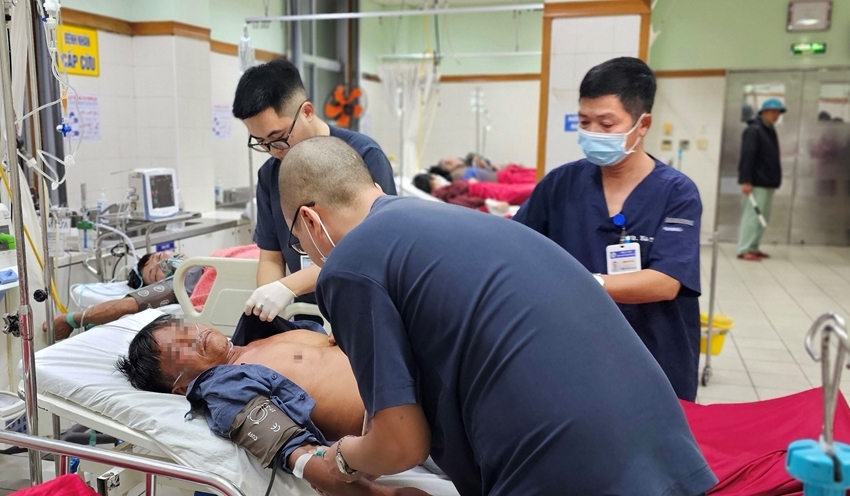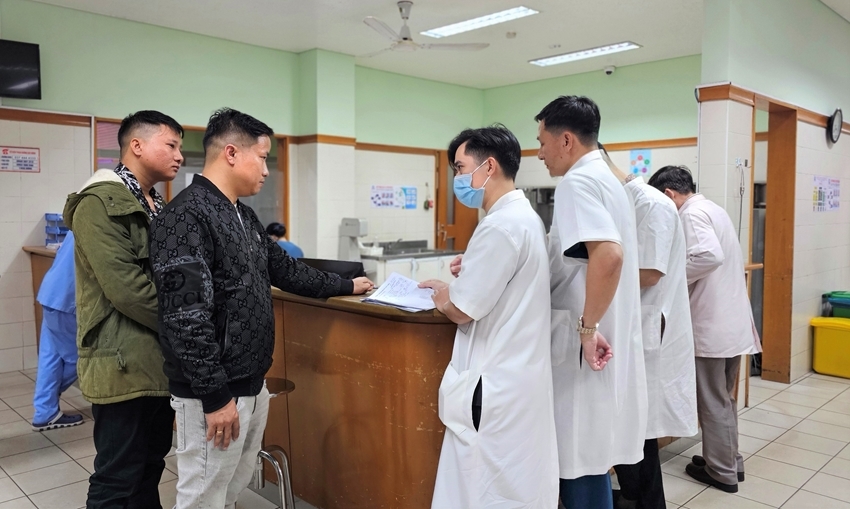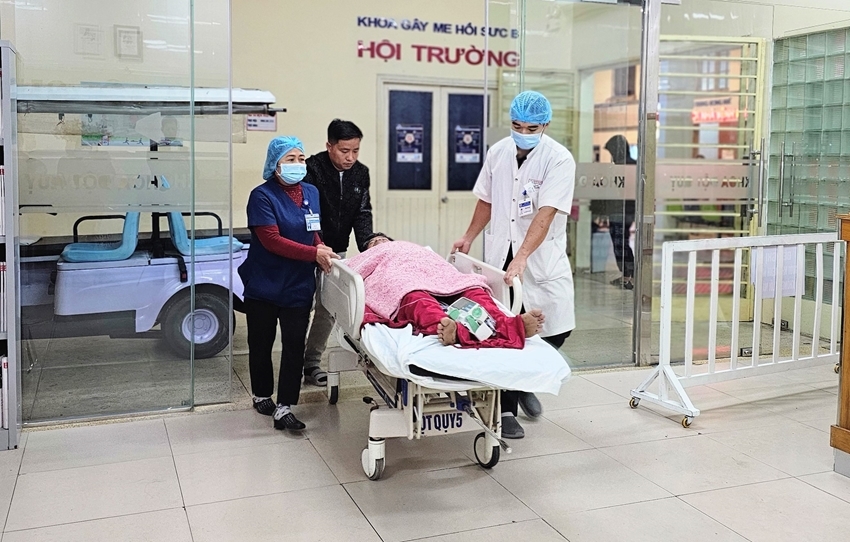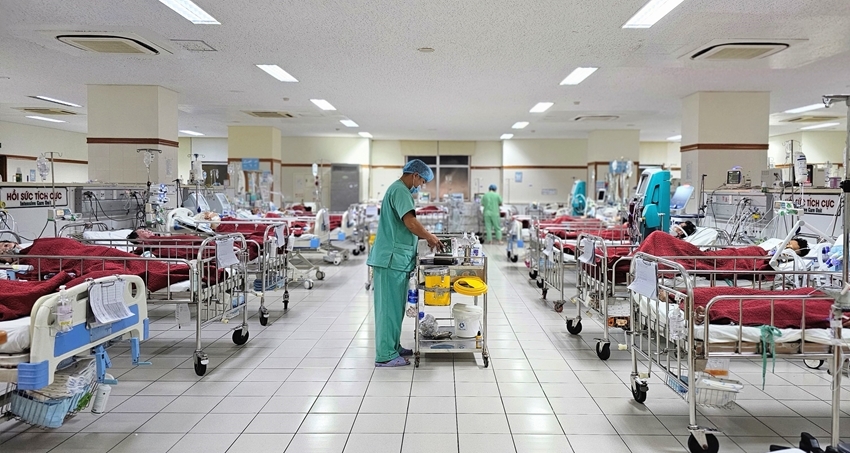 |
| Checking vital signs in the Emergency Department |
The rush at the frontline continues
As of Lunar New Year’s Eve (the 29th day of the lunar calendar), Hue Central Hospital (HCH) had nearly 2,000 inpatients undergoing treatment. In the Emergency Department - the first point of patientadiministration - medical staff were constantly on the move. The sound of trolley wheels rattling, names being called, and announcements for family members to complete procedures made time seem to pass faster. From morning until 5 p.m., the department received 130 patients. In just 15 minutes of observation, we witnessed two accident cases, two stroke cases, and two children brought in by their families due to high fever and seizures.
Duong T., a patient of 57 years old, from Duong No ward, Thuan Hoa district, was diagnosed with ischemic stroke upon admission to the department. The patient's medical history, clinical symptoms, and vital signs were promptly assessed. Le Viet Quan, a nurse in the General Emergency Department, requested authorization to have the patient undergo a CT scan of the cerebral vessels. Upon reviewing the scan results, Quan informed the department leaders and coordinated with the Stroke Department for treatment. He shared: "Everything follows strict protocols, and we handle cases as quickly as possible. In this recent stroke case, after consulting with the Stroke Department, we anticipate administering thrombolytic medication directly to dissolve the clot and save brain cells before moving forward with further intervention."
During the early days of the Lunar New Year holiday, Hue Central Hospital received an average of 15 to 20 traffic accident emergency cases per day. One of these cases was 61-year-old patient, Nguyen T.C. from Phu Vang District. Mrs. C. had an accident while riding a motorbike and was already in a coma when transferred to the hospital. A CT scan showed a brain hemorrhage with a possible cervical vertebra injury. Another CT scan is planned in an hour to reassess the extent of the brain hemorrhage. The on-duty medical team is closely monitoring her coma condition to determine the next course of action.
Proactively planning in advance, the Department of Emergency and Intensive Care assigned a 24/7 duty team working in shifts and prepared sufficient medical equipment and medications. In addition, communication channels with the 115 Emergency Center and related units were maintained to receive information and quickly coordinate cases in need. An internal hospital coordination mechanism was established to ensure that the Intensive Care Unit, Orthopedics-Trauma, and Surgery departments are always ready to assist in case of patient transfers or specialized treatments. Emergency response scenarios were developed to handle situations such as traffic accidents, mass poisoning, or sudden disease outbreaks.
 |
| Explaining to the families of patients during coordinated treatment |
Dr. Truong Viet Hoang, Ms.c., Deputy Head of the Emergency and Intensive Care Department, shared: "On average, we receive 150 to 170 cases per day, but during holidays and the Lunar New Year, it can rise to 200 cases or more. In addition to traffic accidents, typical conditions include asthma, chronic obstructive pulmonary disease (COPD), and strokes. Despite the high patient load, responsibilities are clearly divided so that each team performs its tasks effectively. Moreover, the department has prepared a waiting list and is ready to reinforce manpower. Staff members are not allowed to turn off their phones even after their shift ends; when required, they must be present at the scene within 30 minutes."
Having been got used to the intense workload during Tet duty, the staff of the Emergency and Intensive Care Department shared that their simple joy is celebrating New Year's Eve together. Although they are close to the fireworks display site, they never get the chance to look up and see it. They only hear the sound of fireworks, knowing it's the moment of the new year, feeling a mix of wistfulness before immediately returning to their work.
All for the patients
During Tet, the Stroke Department may have fewer family members waiting outside compared to usual, but inside, the duty team is busy monitoring screens, operating dialysis machines, and administering IV fluids. The son of the patient Duong T., who had just been transferred from the emergency unit, appeared quite anxious. He said, "My father suddenly collapsed while having a year-end meal with the family. After being admitted to the hospital, he was diagnosed, given emergency treatment, and transferred swiftly. Now, everything is entrusted to and dependent on the doctors; our family has already accepted that we'll be spending Tet in the hospital with my father."
 |
| Patient transferred to the Stroke Department |
According to Dr. Tran Thanh Tu from the Stroke Department, the sudden cold weather increases the risk of stroke recurrence, causing the number of cases to rise by 20-30% compared to regular days. The department is currently treating nearly 100 cases, with 10-15 new patients each day. Each shift lasts 24 hours and consists of 12-15 staff members, including 2-3 doctors on duty in the intensive care and emergency areas.
At the Cardiovascular Center, the pace of work continues steadily, regardless of day or night, holidays, or Tet. In the interventional cardiology emergency department, healthcare staff work 24-hour shifts, ready to perform interventions within the first 3-6 hours of a patient's arrival, ensuring timely life-saving treatment. "In addition to ensuring sufficient equipment and facilities, the center will mobilize additional personnel to handle severe and complex cases. The nature of healthcare during holidays and Tet is quite challenging, so we are committed to the spirit of 'all for the patients' to fulfill our duties," shared Dr. Ho Anh Binh, Director of the Cardiovascular Center.
No less stressful and demanding is the Intensive Care Unit (ICU), where critically ill patients are cared for on the edge between life and death. Waiting anxiously for his turn to visit his father, Tran Ngoc D. couldn't sit still. He shared, "My father is 80 years old, suffering from severe pneumonia along with multiple underlying conditions, and was just admitted on the 28th of Tet. My siblings and I are waiting in the hallway, taking turns staying here to monitor his condition. We are so grateful to the nurses and staff in the department. Every time I go in and see all the machines, wires, and patients lying everywhere, it’s overwhelming. Coming to the hospital during Tet really makes me appreciate how hard the doctors and nurses work under huge pressure."
 |
| Monitoring critical cases in the Intensive Care Unit |
Meanwhile, inside the ICU, Dr. Nguyen Thai Thuan, Deputy Head of the Intensive Care Department, was conducting examinations while reminding the team to continuously monitor the cases. He said: 'The trend of severe cases is increasing, especially cases of lung disease, heart failure, and septic shock. Currently, there are 60 severe cases here requiring resuscitation and mechanical ventilation... The on-duty team includes 10 nurses, 2 assistants, and 2 doctors working in 3 shifts. The department has carefully prepared everything; the patients' families can rest assured and entrust the treatment to us.”
Every year during Tet, Dr. Thuan participates in direct treatment, on-call duty, and department head shifts, at least two shifts. When asked about the hardships, he responded: “The nature of the medical profession is to care for and serve the public's health. After decades of “battle,” everyone has become accustomed to it. We only hope that the patients recover soon and can return to their families, and that is when we are happy.”
Specialist II, Dr. Hoang Thi Lan Huong, Deputy Director of Hue Central Hospital, said: “In order to ensure emergency work as well as patient treatment, and to optimize emergency response plans during Tet, Hue Central General Hospital has developed a plan and assigned specific tasks to key departments such as General Emergency, Intensive Care, Post-Operative Care, Clinical Hematology, etc., with doctors on duty 24/7. In addition, the unit also ensures off-site emergency services, providing sufficient blood supplies, and delivering timely emergency care and treatment to patients. The advisory departments also provide timely support around the clock to ensure professional tasks are carried out effectively.”